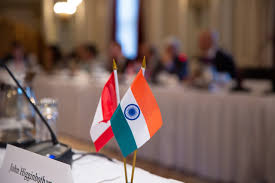On his 108th birthday, Wichterle’s life and legacy are honoured in today’s Doodle.
Google, the world’s largest search engine, is commemorating Otto Wichterle’s 108th birthday today, October 27. He was a well-known Czech scientist credited with being the inventor of the contemporary soft contact lens. Millions of people’s lives have been altered as a result of his innovation.
Making the day even more unique, Google has released a Doodle featuring Wichterle holding a single contact lens between his fingertips. The light is reflected from the Google logo in the background that represents eyesight as he does so.
“Thank you for helping the world see eye to eye, Otto Wichterle—happy birthday!” Google penned something.
His breakthroughs paved the way for cutting-edge medical technologies like “smart” biomaterials, which are used to restore bio-recognizable polymers and connective tissues in humans. During the 1950s, he worked as a lecturer at his alma university while creating an absorbent and translucent gel for ocular implants.
Wichterle was forced out of the ICT because of political upheaval, but that did not stop him from continuing his progress. At home, he proceeded to fine-tune his hydrogel development.
Wichterle (a spectacles user) created the first soft contact lenses in 1961 using homemade equipment consisting of a child’s erector set, a bicycle light battery, a phonograph motor, and handmade glass tubing and moulds.
About Otto Wichterle:
Wichterle, born on October 27, 1913, in Prostjov, Czech Republic (then Austria-Hungary), was a lifelong science enthusiast. Wichterle earned his doctorate in organic chemistry from the Prague Institute of Chemical Technology (ICT) in 1936 due to his interest and passion for the subject.
Otto’s father, Karel, was a co-owner of a thriving farm-machine manufacturer and a small automobile plant, but Otto chose science as his profession. Wichterle began studying at the Czech Technical University’s Chemical and Technological Faculty (now the autonomous University of Chemistry and Technology, Prague) after graduating from high school (today’s Walker Grammar School) in Prostjov, but he was also interested in medicine.
In 1936, he received his bachelor’s degree and continued his education at the institution. In 1939, he presented his second doctoral thesis on chemistry, but the Protectorate rule halted all academic work.
In 1939, he completed his second doctoral thesis in chemistry, but the Protectorate administration prevented him from continuing. Wichterle, on the other hand, was able to continue his scientific work by joining the research institution at Baa’s works in Zln. At that time, he was in charge of the technical preparation of plastics, specifically polyamide and caprolactam.
Wichterle’s team created throwing and spooling polyamide thread in 1941, resulting in the first Czechoslovak synthetic fibre, silicon (the invention came independently of the original American nylon procedure in 1938). In 1942, the Gestapo imprisoned Wichterle, but he was released after a few months.
Wichterle returned to the university, concentrating in organic chemistry and teaching general and inorganic chemistry. He developed an inorganic chemistry textbook with a concept ahead of its time and organic chemistry textbooks in German and Czech.
In 1949, he completed his second PhD in plastics technology and dedicated himself entirely to creating a new department of plastics technology. In 1952, he was named dean of Prague’s newly founded Institute of Chemical Technology.
By late 1961, Wichterle had created the first four hydrogel contact lenses using a home-built apparatus that utilized a Merkur children’s construction kit, a bicycle dynamo owned by one of his boys, and a bell transformer. Wichterle also created all of the monomer-dosing moulds and glass tubing.
Wichterle ultimately succeeded on Christmas afternoon with the aid of his wife Linda and the machine on his kitchen table. He tried the lenses in his own eyes and found them pleasant, even though they were the incorrect power. As a result, he devised a novel method of lens production based on centrifugal casting. Linda produced 5,500 lenses.
The early experimental lenses were known as Geltakt, while the later manufacturing lenses were known as Spofalens, after the state-owned company that made them.
National Patent Development Corporation (NPDC) purchased the American rights to manufacture the lenses in 1965 and subsequently sublicensed them to Bausch & Lomb, who began manufacturing them in the United States.
The patents were challenged in 1977, primarily by Continuous Curve Contact Lenses, and the CSAS surrendered the patents in May 1977 to avoid liability if the court action failed. Wichterle and the NPDC, on the other hand, won the court case in 1983.
Some of Otto Wichterle Achievments:
Wichterle became well-known outside of Germany for his achievements and his involvement in international organizations, the most notable of which was the International Union of Pure and Applied Chemistry (IUPAC).
He was involved in the planning of the organization’s Prague symposia in 1957 and 1965, which were well received by attendees; he was involved in the founding of its fifth division, macromolecular, of which he was to become the first president; and he gained further credit by combining within it what were previously separate fields of pure and applied chemistry for administrative purposes.
He was banned from the institute for the second time in 1970 for signing “The Two Thousand Words,” a manifesto calling for the continuation of the democracy movement started during the Prague Spring in 1968.
The dictatorship punished him by removing him from his managerial roles and made his research more difficult, primarily by cutting off his international contacts and reducing his teaching prospects. The Velvet Revolution in 1989 was the catalyst for full recognition.
In 1990, he was made president of the Czechoslovak Academy of Sciences till the dissolution of Czechoslovakia. He was the honorary president of the Academy of Sciences of the Czech Republic after that. Wichterle was a member of several foreign science academies, and he received many awards and honorary doctorates from several universities.
The asteroid number 3899 was named after Wichterle in 1993. Furthermore, a high school in Ostrava (in the district of Poruba) in the Czech Republic was named after him on September 1, 2006. On October 27 2021, Google celebrated Wichterle’s 108th birth anniversary with a doodle on its homepage.
References:
https://en.wikipedia.org/wiki/Otto_Wichterle













